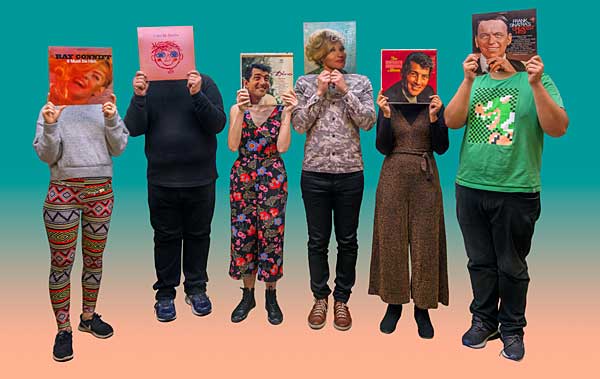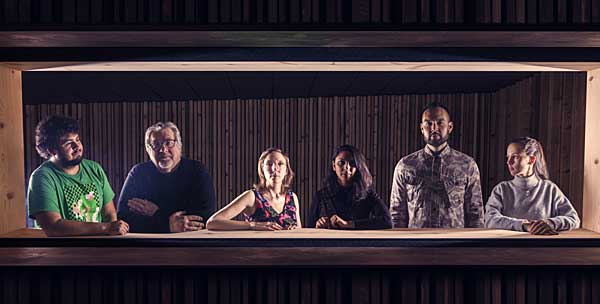| Columns Retired Columns & Blogs |
An excellent article and interview -KM.
Halvorson: Sometimes I'll use a slide to make buzzy types of sounds, but generally I don't treat it. The pitch-bending thing is a Line 6 Delay Pedal.
Micallef: Were you already involved in experimentation when you arrived to study at Wesleyan?
Halvorson: That's where I got into more experimental music, at Wesleyan. I went there not intending to major in music, maybe take a few music classes. When I started college, I was probably playing more straight-ahead jazz, just 'cause that's what I was learning. When I went to Wesleyan and studied with Anthony Braxton, that's when things really opened up for me.
Micallef: How do you think about the sound of your records and how they'll appeal to listeners, and does that affect your record production?
Halvorson: That's one of the beautiful things about making a record, as opposed to performing live: You can really tune in to all the nuances of sound and balance and trying to get everything just right. I spend a lot of time thinking about the mix and the individual sounds of the instruments and how everything fits together. We recorded the latest album for the label Firehouse 12. They have two recording studios in New Haven and the label owner is also the engineer, Nick Lloyd. Their second studio is almost like a cathedral space; that's where we recorded this. We got really good sounds. At the same time, it was a tough record to mix because there's three different voices, two horns—there's a lot happening. I wanted it to sound dynamic but also to sound blended. That's sometimes a hard balance, especially with vocals. I wanted the voices to sit in the music, as if the vocals were another horn, as opposed to the vocals being twice as loud as everything else as on rock records. It took some work. I put quite a lot of thought into how the record sounds.
Micallef: Your audio system consists of ProAc Studio 100 speakers, Audeze LCD-X headphones, Bose Wave Music System III, and an early 1960s KLH Model Eleven, which is an all-in-one portable system with turntable, amplifier, and detachable speakers.
Halvorson: My dad gave me the KLH, which I use when I listen to records, and the Bose if I want to quickly throw on a CD. I love the KLH. If I play a record on it, it sounds beautiful. I've never tried to get another record player. That's the only one I've ever had. Records sound very warm, very present on the KLH. You can really hear all of the sounds and all the scratches. It's probably not the cleanest player, but it has a lot of character, and you can hear all the details of the vinyl.
Micallef: How are you driving the ProAcs?
Halvorson: Those are hooked up to a Pioneer VSX-830-K receiver. It's connected to my TV. I can plug in an external USB stick to it and listen to music from my computer. I listen to a lot of different things using the ProAcs.
Micallef: Where does the Bose system come into play?
Halvorson: The Bose is very bass heavy, which can be nice for certain things, but the ProAcs are very true. You hear so much detail. If I'm listening to a mix, it lets me hear all the details. It doesn't color the sound in one way or the other. It's very clear. That's what I like about the ProAcs.
Micallef: Your Audeze LCD-X headphones are true high-end.
Halvorson: My Code Girl coproducer, David Breslin, recommended the ProAcs and the Audeze. He said, "You're a musician. You need a really good pair of headphones." For me, again, it's that clarity, and the imaging of those headphones is amazing. To be able to hear every detail. It's amazing to have those headphones in a recording session and hear the other musicians in a way that sounds good. It doesn't feel irritating to have these headphones in a studio. They're also very comfortable, which is unusual. Usually my head is killing me, but by the end of the day in the studio with the Audeze my head feels fine.

Micallef: Anthony Braxton called you Code Girl?
Halvorson: I called the band Code Girl as a nod to Anthony Braxton. We were on the road and he'd said, "Code Girl." At the time I was working on lyrics and titles and thought, "Oh, that's cool."
I always carry this notebook where I write down phrases. He said, "What's the code?" I've no idea what he was talking about, but he told me the code was "5555." I wrote down, "Code Girl (5555)." I thought it would be an interesting band name. So, it's a nod to one of my most important teachers and mentors. Also, the lyrics on the album are pretty coded. On the first album, there are a lot of 5s embedded in the album art.
Micallef: What's the goal for Artlessly Falling, the second Code Girl album?
Halvorson: One is that I wanted multiple singers. One of my biggest heroes, Robert Wyatt, is a guest. That's very exciting for me, that he was even open to doing it. I wrote a few songs specifically for him. And in addition to adding the poetic forms for the lyrics I wanted a little more cohesion. We knew these songs very well when we recorded them.
Micallef: Why is Robert Wyatt a hero?
Halvorson: I remember so clearly the first time I heard his album, Rock Bottom (footnote 4). It was one of those moments like with Johnny Smith. I remember being bowled over by it. For me, music is very emotional, and you can't always grasp exactly why something is hitting you so hard. Robert Wyatt's music, its beauty and the emotions that come with it, is unique and strong. It's simultaneously beautiful and unique and strange. A perfect balance of those elements. He's making these beautiful songs that don't sound like anything else. I'd send him a sample of me singing a song and playing guitar so he could get a sense for whether it's something he'd be open to singing. I didn't want to give him too many instructions. I loved everything he did.

Micallef: The song "Last-Minute Smears" quotes Supreme Court Justice Brett Kavanaugh.
Halvorson: Just taking words from his congressional testimony in 2018. He was angry and indignant and caused people to say these hyperbolic things, like "people will die." I wanted to turn it into a song. It's a snapshot of that moment in time and also symbolic of the larger problems we're facing as a country. Amirtha's vocals gave it a mournful quality. Made it a sad song instead of something angry and indignant. It's not a political album, it's not an album of love songs. It's about the crazy state of the world.
Micallef: How do you feel about media coverage of female jazz artists in the me-too era?
Halvorson: It's great. When I started playing guitar as a teenager, I didn't know of other women playing jazz guitar. I had no female role models. I was very lucky because I had a lot of very cool, very positive male role models who encouraged me and were very inclusive. But a lot of women are very discouraged from starting out in the music, because it might feel like a boys' club, or because none of their girlfriends are playing jazz or playing instruments. The momentum is changing now, and the more women that do it, the more examples young women starting out will have to point to. That's really important. What I hope is ultimately you won't have to showcase women in that way because it will be more of an equal balance. That shift is already happening. It's not uncommon for me now to play in bands where women outnumber men. I'm playing with Tomeka Reid, Ingrid Laubrock, Jessica Pavone, Kris Davis, Susan Alcorn, Amirtha, Maria Grand. I'm playing with women all the time. That's really, really fantastic. There's still a way to go, but it's deserving of attention, and it's great that the momentum is changing

An excellent article and interview -KM.


I saw Mary Halvorson play with Thumbscrew in a church here in Portland, OR. Was one of the best shows and sound was killer good. I love her playing so much. Great insights from this interview. Thanks for sharing.

Mary Halvorson almost seems a bit too academic at times, but none-the-less her art is brilliant to my ears.
I caught her live (pre-Covid with Code Girl & Thumscrew most recently) and the music was stellar.
I would thoroughly enjoy if she stood up from the music stand and shred like the inner guitar god that lives within her however. Until then, I will keep listening to her brilliant work hoping others join in.